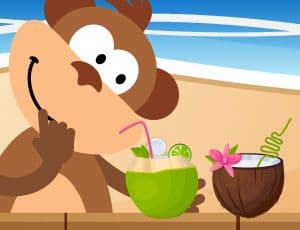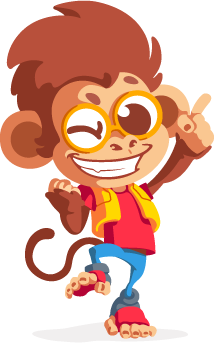Escola Games | Jogos Educativos
https://www.escolagames.com.br
Teacher's support sheet

Even or Odd
Come to the beach and play with the little monkeys! They want to know the difference between even and odd numbers.
Fun is guaranteed and whoever accepts the challenge will be able to surf and cool off with delicious coconut water.

Teacher's tips
Level of education: Elementary School I
Age: 06 to 09 years old
The need to study the concept of even and odd is one of the important curricular components of mathematics, as this will be essential for the development and understanding of the four basic operations. This subject must be approached from different perspectives, seeking its understanding and organization, as well as significant learning. This learning can be provided through games and recreational activities. After making this game, perform some of the suggestions that we have separated for a better development of the theme. [FIM-DICA]
Learner outcomes
Stimulate mathematical logical reasoning;
Expand the understanding of the decimal numbering system through the study of a characteristic of its elements: even or odd;
Identify and write the sequence of even and odd numbers;
Fix learning and systematize the concepts of even and odd;
Systematize the concept of even and odd;
Solve problem situations with the proposed theme;
Teachers' goals
Work with the concept of even and odd numbers;
Offer situations in which students can analyze, identify and differentiate even and odd numbers;
Stimulate the taste for Mathematics, through playful and pleasurable activities;
Reinforce content worked in the classroom;
Stimulate the exchange of knowledge, socialization and interaction among students;
Suggestions of approaches for the teacher
For the realization of this class it is necessary that the student is able to orally expose his ideas and relate to his colleagues. In addition, you need to recognize the decimal numbering system.
When conducting the learning process, provide activities that allow the child to realize that, when dividing a natural number by two (2) and the division is exact, the number is even; and when there is remainder, the number is odd.
(Suggestion 1) Separate the class into pairs for the plays. Each pair should take a sheet, pencil and eraser. In the 1st round, a member of the pair must mark the numbers requested. Meanwhile, the other member must write down the numbers that the colleague marked in the move. As they do this, they should exchange ideas about the numbers.
Only after copying the numbers should they click on the “verify” icon, as the numbers will disappear shortly afterwards, starting another round.
The roles of the members of the duo will be changed at each turn.
At the end, a surfer monkey game will be proposed. In this stage there should also be a relay, as only one player participates. It is important to make it clear to the students that, even if a colleague controls the keyboard, the two students should constantly exchange ideas about the numbers that appear.
(Suggestion 2) Build track of even or odd numbers and use it to play in groups. In this activity, the creation of obstacles should also be included in the proposal.
(Suggestion 3) Connect odd or even numbered dots.
(Suggestion 4) Put numbers in ascending and/or descending order.
(Suggestion 5) Interdisciplinary work with the Portuguese teacher. Promote storytelling with the books “The centipede and her shoes” by Milton Camargo and “The revolt of numbers” by Odette de Barros Mott. The objective of this activity is to use literature, through history connected with Mathematics, to provide a context of multiple possibilities for exploring concepts about numbers.
(Suggestion 6) Construction of a collective mural for the school with clippings from newspapers and magazines containing numbers and a list of situations and places where numbers can appear and what is their use in each situation.
(Suggestion 7) Promote the traditional game of Bingo, but in this bingo the sequence of numbers that wins is the sequence of even or odd numbers as determined by the teacher.
(Suggestion 8) Make posters or cards with numbers from 1 to 100. The even cards must be of the same color and represented by specific drawings that correspond to the indicated number. Odd cards must be indicated in a different color and also by drawings that represent the number indicated. This activity will allow the child to realize that there is no consecutive repetition of two odd numbers or two even numbers.
(Suggestion 9) Play the chair game with the students.
(Suggestion 10) Hopscotch game, where the child should jump only on even or odd numbers, according to the numerical position where the object was thrown.
(Suggestion 11) Market. Divide the children into two groups; the market group and the customer group. The market group should be responsible for organizing and pricing the items to be sold. The customer group must pay for these products with cash (play money). Promote this activity with 3rd grade students, who have a better understanding of basic mathematical operations.
(Suggestion 12) Ask the students to organize themselves into two groups. If you have an odd number you can be part of one of them. Then ask questions for them to reflect, exchange ideas and answer:
How many students are in our classroom today?
To separate two groups with the same amount of children, what did we have to do?
How many students were in each group?
How many groups of two students can we divide the room into?
How many groups of three students can we divide the room into?
What can we do to divide the room into equal groups and no one is left alone?
(Suggestion 13) Then ask the students to remove their shoes and place them, mixed, in a corner. Each group at a different point. The socks too.
At the agreed time, everyone must find pairs of shoes and pairs of socks. The group that finishes 1st, scores a point.
Once the game is over, sit down to talk about the amount of shoes there were, how many pairs they managed to make, how many feet of shoes we need to make a pair, and two pairs, and three, etc...
Systematizing the information, together with the students, record what they learned from this activity.
(Suggestion 14) Make a poster about 3 meters long and print numbers from 0 to 200. Using colored crayons, ask the students to circle the even numbers in one color and the odd numbers in another. This activity can also be reduced to an A4 sheet and worked on individually or in smaller groups.
More about the content
By studying and deepening the contents that address teaching and learning in the early grades, we have always noticed and verified how important it is to offer games as strategies for new constructions of knowledge, as well as to evaluate what has already been achieved.
From our proposals, the teacher can adapt the syllabus content to the game, using creativity to expand their material.
It is important to emphasize that, in order to become a productive work, the game needs a well-planned didactic strategy guided by the teacher. Simply turning on the computer and letting the child play cannot guarantee learning nor be understood as an opportunity for the child to build some knowledge.
